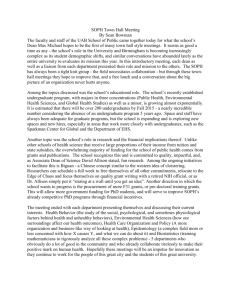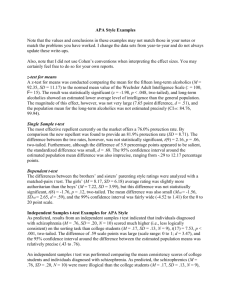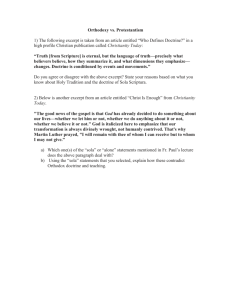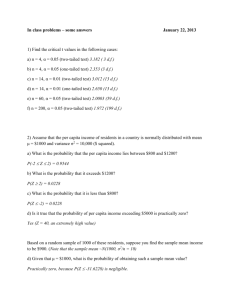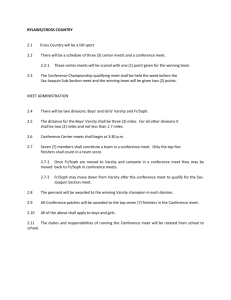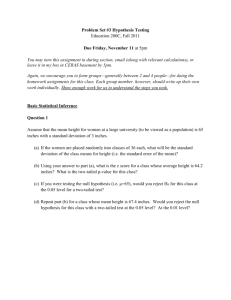Homework 4 WORD file - UAB School of Public Health
advertisement
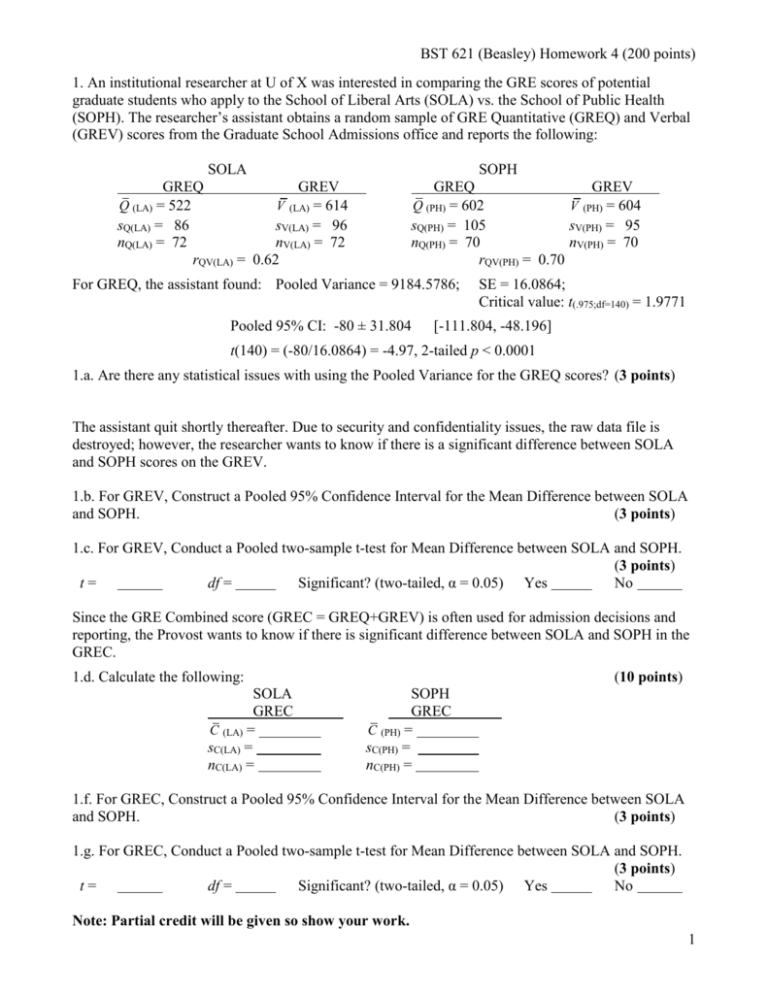
BST 621 (Beasley) Homework 4 (200 points) 1. An institutional researcher at U of X was interested in comparing the GRE scores of potential graduate students who apply to the School of Liberal Arts (SOLA) vs. the School of Public Health (SOPH). The researcher’s assistant obtains a random sample of GRE Quantitative (GREQ) and Verbal (GREV) scores from the Graduate School Admissions office and reports the following: SOLA SOPH GREQ GREV (LA) = 614 sQ(LA) = 86 sV(LA) = 96 nQ(LA) = 72 nV(LA) = 72 rQV(LA) = 0.62 Q (LA) = 522 GREQ Q (PH) = 602 V sQ(PH) = 105 nQ(PH) = 70 rQV(PH) = 0.70 For GREQ, the assistant found: Pooled Variance = 9184.5786; Pooled 95% CI: -80 ± 31.804 GREV (PH) = 604 sV(PH) = 95 nV(PH) = 70 V SE = 16.0864; Critical value: t(.975;df=140) = 1.9771 [-111.804, -48.196] t(140) = (-80/16.0864) = -4.97, 2-tailed p < 0.0001 1.a. Are there any statistical issues with using the Pooled Variance for the GREQ scores? (3 points) The assistant quit shortly thereafter. Due to security and confidentiality issues, the raw data file is destroyed; however, the researcher wants to know if there is a significant difference between SOLA and SOPH scores on the GREV. 1.b. For GREV, Construct a Pooled 95% Confidence Interval for the Mean Difference between SOLA and SOPH. (3 points) 1.c. For GREV, Conduct a Pooled two-sample t-test for Mean Difference between SOLA and SOPH. (3 points) t= df = Significant? (two-tailed, α = 0.05) Yes No Since the GRE Combined score (GREC = GREQ+GREV) is often used for admission decisions and reporting, the Provost wants to know if there is significant difference between SOLA and SOPH in the GREC. 1.d. Calculate the following: SOLA GREC C (LA) = sC(LA) = nC(LA) = (10 points) SOPH GREC C (PH) = sC(PH) = nC(PH) = 1.f. For GREC, Construct a Pooled 95% Confidence Interval for the Mean Difference between SOLA and SOPH. (3 points) 1.g. For GREC, Conduct a Pooled two-sample t-test for Mean Difference between SOLA and SOPH. (3 points) t= df = Significant? (two-tailed, α = 0.05) Yes No Note: Partial credit will be given so show your work. 1 BST 621 (Beasley) Homework 4 (200 points) 2. Suppose a test statistic has a Type I error rate of α = 0.05. That is, 5% of the time the test will reject the null hypothesis when the null hypothesis is actually true. Now suppose the K=3 tests conducted in the previous analyses were independent. 2.a. What is the probability of at least one failure, P(r ≥ 1) = _____________. (3 points) 2.b. Is it reasonable to assume that these tests were independent? Explain. (3 points) 3. An obesity researcher wanted to investigate the effects of a 12-week diet and exercise program on obese women. The participants were N=25 females recruited from a local bariatric physician. All participants had a body mass index (BMI) in excess of 26. The participants BMI and resting metabolic rate (RMR) were measure before and after the 12-week program. The data for this is in the Microsoft Excel file (BST621-Assign4-BMI.xls) SPSS: Use Analyze-Compare Means-Paired Samples T-Test and choose PRE and POST variables as pairs Use Analyze-Compare Means One Sample T Test and use the DIFF variables as Test Variables JMP: Use Analyze-Matched Pairs enter the PRE and POST variables as Y, Paired Response Use Analyze-Distributions enter the PRE POST and DIFF variables Under the DIFF Banner select the Test Means Option SAS: Use PROC MEANS N MISS MEAN STD VAR STDERR T PROBT;VAR PRE POST DIFF; Use PROC TTEST; PAIRED PRE*POST; RUN; and 3.a. In symbolic notation, what was the null hypothesis for the previous analysis? (The null hypothesis was the same for both variables.) 3.b. Enter the following Results. Pre BMI Post (2 points) (28 points total) 95% CI (Mean Diff) Lower Bound Upper Bound Mean Diff Mean SD t p-value SE(MDiff) n r Pre RMR Post df 95% CI (Mean Diff) Lower Bound Upper Bound Mean Diff Mean SD t p-value SE(MDiff) n r df 3.c. For both the BMI and RMR, interpret each 95% CI. (4 points) 3.d. How would missing data affect the interpretation of these results? (3 points) 3.e. What other limitations does this study have? (3 points) 2 BST 621 (Beasley) Homework 4 (200 points) 4. Based on these data, conduct a Power analysis for the RMR results. (Daniel, Section 7.9) Use SAS: proc power; pairedmeans test=diff OR pairedmeans = XXX | YYY corr = 0.4 pairedstddevs = (S1 S2) npairs = . (VALUE or .) power = 0.9 (VALUE or .);run; proc power; onesamplemeans test=t mean = 7 stddev = 3 ntotal = 50 (VALUE or .) power = . (VALUE or .); run 4.a. What was the “Observed Power” for the RMR results at a two-tailed = 0.05.? (3 points) 4.b. Holding these data (Means and SDs) constant, what would a future Total Sample Size (N=number of pairs) need to be for the RMR results to be statistically significant at a two-tailed = 0.05.? (3 points) 4.c. Holding these data (Means and SDs) constant, what would a future Total Sample Size (N=number of pairs) need to be for the RMR analysis to have 80% Power (1 – = 0.80) at a two-tailed = 0.05.? (3 points) 4.d. Given YOUR DECISION on whether or not to Reject the Null Hypothesis for RMR, what is the Probability of a Type I Error? (3 points) 4.e. Given YOUR DECISION on whether or not to Reject the Null Hypothesis for RMR, what is the Probability of a Type II Error? (3 points) 5. Write a brief interpretation of these results. (5 points) 6. Suppose a researcher was interested in doing a research study on the change in Glucose level after taking metformin among Diabetics. She finds a report from her clinic showing the Mean, Standard Deviation, sample size (n), and fortunately the correlation (r) for the Blood Glucose Level for n=20 patient Before and After taking metformin : (14 points) 6.a. Fill in the blanks Before BGL Mean 218 SD 52 After 175 50 95% CI Lower Bound Upper Bound Mean Diff t p-value SE(MDiff) n 20 20 r 0.65 df 6.b. What was the “Observed Power” for the BGL results at a two-tailed = 0.05? (3 points) 6.c. Holding these data (Means and SDs) constant, what would a future Total Sample Size (N=number of pairs) need to be for the BGL analysis to have 80% Power (1 – = 0.80) at a two-tailed = 0.05.? (3 points) 6.d. Holding these data (Means and SDs) constant, what would a future Total Sample Size (N=number of pairs) need to be for the BGL analysis to have 80% Power (1 – = 0.80) at a two-tailed = 0.01.? (3 points) 3 BST 621 (Beasley) Homework 4 (200 points) 7. Based on Schwartz et al. (1991), a researcher investigated the effect of cigarette smoking on lung functioning in patients with idiopathic pulmonary fibrosis. The researcher collected the patient’s smoking history and measured their percent predicted residual volume (PPRE). Never 65 100 82 57 84 86 90 107 94 Former 120 60 52 80 103 Directions for 7.b. – 7.d. Current SPSS: Use Analyze-Compare Means –One Way ANOVA and 105 Select PPRE as the Dependent Variable and Group as Factor 99 Select Options – Descriptive statistics, Homogeneity of Var Test, Welch 103 Select Post-Hoc and Check the Tukey option 104 JMP: Change the X variable to Nominal, then Use Analyze-Fit Y by X 115 Under the Oneway Analysis Banner select the 107 Means/Anova/Pooled t and Means and Std Dev 109 Compare Means – All Pairs, Tukey HSD options SAS: Use PROC GLM; CLASS group; model PPRE = group / solution; MEANS group / tukey; RUN; 7.a. State the omnibus null hypotheses for this one-way analysis of variance (ANOVA). (3 points). 7.b. Complete the ANOVA Source Table with SS, df, MS, and F, and test the null hypothesis in (1) at the = .05 level of significance. (5 points) Source SS df Between ______ ___ MS F p-value _____ ____ _____ Within _______ ___ _____ ___________________________________________________________________________ Total ________ ___ 7.c. What is the Model R2? R2 = _______ (2 points) 7.d. Compute Tukey HSD for each pairwise comparison. Mean Diff Lower Bound Never vs Former Never vs Current Current vs Former (9 points). Upper Bound 7.e. Based on these results explain which groups are significantly different and which group if any has worse lung functioning. (4 points). 8. Do you think there is a causal relationship between these variables? Explain. (3 points). 9.a. What was the “Observed Power” for these results at a two-tailed = 0.05? (3 points) 9.b. Holding these data (Means and SDs) constant, what would a future Total Sample Size (N) need to be for a similar to have 80% Power (1 – = 0.80) at a two-tailed = 0.05.? (3 points) 10. Write a brief interpretation of these results. (4 points) 4
